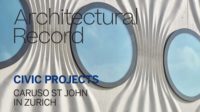It seems counterintuitive to do an issue on tall buildings when so many tall buildings in cities across the U.S. are currently plagued with too much empty office space (despite a recent leasing uptick, particularly in New York). Why would we need more of them? And those pencil towers for luxury residences that make up places like Billionaires’ Row at the southern end of Central Park in Manhattan need to be seen as a special case, functioning more as bank vaults than apartments. They mostly sit empty as well. Who wants more of those?
But, as Norman Foster said in January at the launch of a master’s program his institute has created with the Universidad Autónoma de Madrid, “Cities really are our future. By 2050, 90 percent of the global population will be living in cities.” And if Norman Foster said it, it must be true. The architect’s talking skills were part of what convinced David Levinson, chairman and CEO of L&L Holdings, to hand over a reported billion-dollar commission for a 47-story office tower on Manhattan’s Park Avenue to Lord Foster of Thames Bank.
In our current situation, it is these kinds of super-high-end office buildings that are faring better than the shorter, dumpier ones, and are the structures that continue to get built (including another Foster tower at 270 Park Avenue for JPMorgan Chase—it being responsible for the disruption of the view from RECORD’s office that I grumbled about in last month’s letter). According to an August 2023 Moody’s Analytics report, at the national level, high-floor office buildings that contain 20 or more floors consistently had lower vacancy rates than low (five floors or fewer) or medium-size (six to 20 floors) buildings.
Since design of this building type goes on, we take a look at Foster’s tower for L&L in this issue, as well as new skyscrapers in London (by WilkinsonEyre), Tokyo (by OMA New York), and Dubai (by Japanese firm Nikken Sekkei, featured on the cover). We also examine lighting schemes for these and other behemoths, which range from subtle to over-the-top to a work of art (literally, by artist Leo Villareal).
And, yes, the competition to build the tallest continues. We give an update on the just-completed Merdeka 118 in Kuala Lumpur, the second-tallest building in the world after Dubai’s Burj Khalifa. And we offer the latest word on the Jeddah Tower—formerly known as the Kingdom Tower—in Saudi Arabia. This future “tallest in the world” structure, which is expected to surpass the Burj Khalifa by at least 560 feet, recently restarted after a long lull, with contractors submitting bids to complete its construction.
But if we really are concerned with the future of our cities, the nature of the tall building will have to change. Imagine a skyscraper that is not a symbol of wealth or kingdom, that contains not offices for hedge fund honchos or hardly occupied second, third, or fourth residences for multimillionaires, but real housing. In our future cities, we need dignified towers, not cookie-cutter blocks for that 90 percent who are not the 1 percent.






Post a comment to this article
Report Abusive Comment